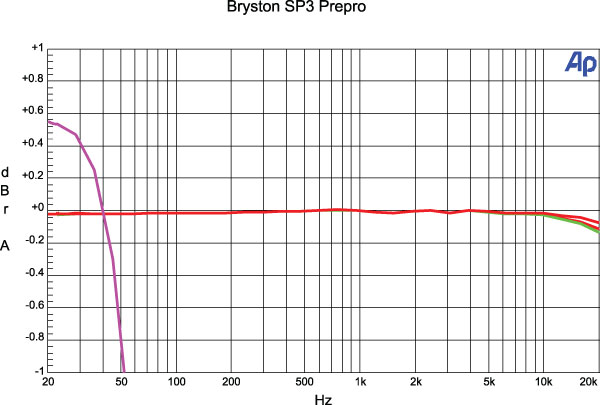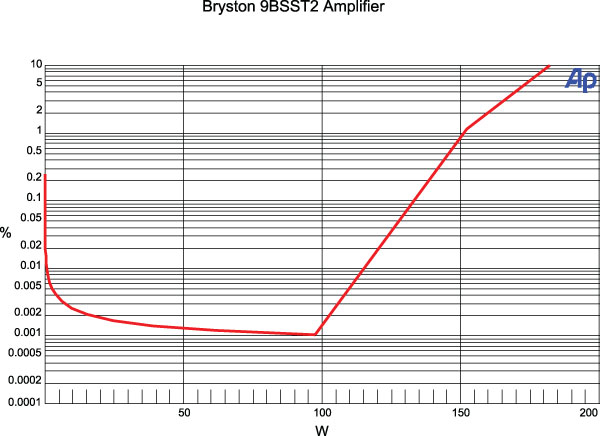Bryston SP3 Surround Processor and 9B SST² Amplifier HT Labs Measures
Bryston SP3 Surround Processor
Analog frequency response in Bypass mode:
–0.07 dB at 10 Hz
–0.01 dB at 20 Hz
–0.06 dB at 20 kHz
–0.42 dB at 50 kHz
Analog frequency response with signal processing:
–0.22 dB at 10 Hz
–0.07 dB at 20 Hz
–0.10 dB at 20 kHz
–12.32 dB at 50 kHz
The chart below shows the frequency response of the left (aqua), center (green), LFE (purple), and left surround (red) channels at the preamp outputs of the Dolby Digital decoder. The left channel measures –0.02 decibels at 20 hertz and –0.11 dB at 20 kilohertz. The center channel measures –0.02 dB at 20 Hz and –0.13 dB at 20 kHz, and the left surround channel measures –0.02 dB at 20 Hz and –0.07 dB at 20 kHz. The LFE channel, normalized to the level at 40 Hz, is +0.54 dB at 20 Hz, reaches the upper –3-dB point at 67 Hz, and reaches the upper –6-dB point at 82 Hz.

Response from the multichannel input to the main output measures –0.05 dB at 10 Hz, –0.01 dB at 20 Hz, –0.06 dB at 20 kHz, and –0.42 dB at 50 kHz. The analog THD+N was less than 0.022 percent at 1 kHz with a 100-millivolt input and the volume control set to +2.5. Crosstalk with a 100-mV input was –92.92 dB left to right and –93.44 dB right to left. The signal-to-noise ratio with “A” weighting was –121.59 dBrA.—MJP
Bryston 9B SST² Amplifier
Two channels driven continuously into 8-ohm loads:
0.1% distortion at 133.2 watts
1% distortion at 151.3 watts
Five channels driven continuously into 8-ohm loads:
0.1% distortion at 129.6 watts
1% distortion at 148.7 watts
Frequency response RCA input:
–0.03 dB at 10 Hz
–0.00 dB at 20 Hz
–0.27 dB at 20 kHz
–4.10 dB at 50 kHz
Frequency response XLR input:
–0.03 dB at 10 Hz
–0.00 dB at 20 Hz
–0.27 dB at 20 kHz
–4.12 dB at 50 kHz

This graph shows that the 9B SST²’s left amplifier channel, with two channels driving 8-ohm loads, reaches 0.1 percent distortion at 133.2 watts and 1 percent distortion at 151.3 watts. Into 4 ohms, the amplifier reaches 0.1 percent distortion at 225.9 watts and 1 percent distortion at 245.5 watts. An input level of 101.5 millivolts was required to produce an output of 2.83 volts into an 8-ohm load, indicating an overall gain of +28.93 decibels using the RCA input and the manufacturer recommended 29-dB gain setting. When using the XLR input, a level of 202.1 millivolts was required to produce an output of 2.83 volts into an 8-ohm load, indicating an overall gain of +22.95 dB using the recommended 23-dB gain setting.
THD+N from the amplifier was less than 0.005 percent at 1 kilohertz when driving 2.83 volts into an 8-ohm load using the RCA input. When using the XLR input under the same conditions, THD+N was less than 0.003 percent. Crosstalk at 1 kHz driving 2.83 volts into an 8-ohm load was –104.90 dB channel 1 to channel 5 and –103.79 dB channel 5 to channel 1 using the RCA inputs and –112.79 dB channel 1 to channel 5 and –112.53 dB channel 5 to channel 1 using the XLR inputs. The signal-to-noise ratio with an 8-ohm load from 10 Hz to 24 kHz with “A” weighting was –105.13 dBrA using the RCA input and –111.10 using the XLR input.—MJP
Video Test Bench
The Bryston SP3 performs no video processing; therefore, the only applicable tests above apply to 1080p in to 1080p out. The processor does fine with resolution and passes a 3D input but unfortunately does not pass above-white or below-black information.

Consumer digital video signals extend across a brightness range specified as levels 16 to 235. However, a video passthrough device such as a surround preamp/processor or AVR should accommodate the entire 0-to-255 digital video range (or close to it) to account for any excess in the source. Clipping at the bottom end in such a device will rarely cause viewing issues but does make it more difficult to set the display’s black level. While you won’t notice white clipping most of the time either, it can smear the gradations in, for example, white clouds on a bright day. This basic requirement is met even by most of the inexpensive AVRs we’ve tested, but the SP3 actually clipped a few steps prior to 235. Serious enthusiasts might consider bypassing the video switching in the SP3, though I don’t consider that a reasonable compromise in so expensive a processor.—TJN




























































